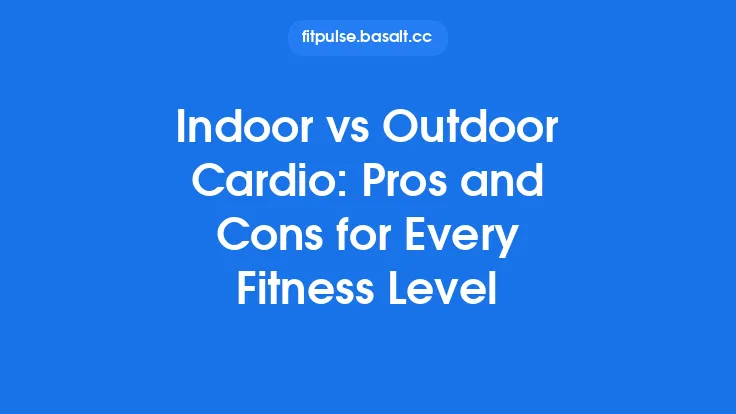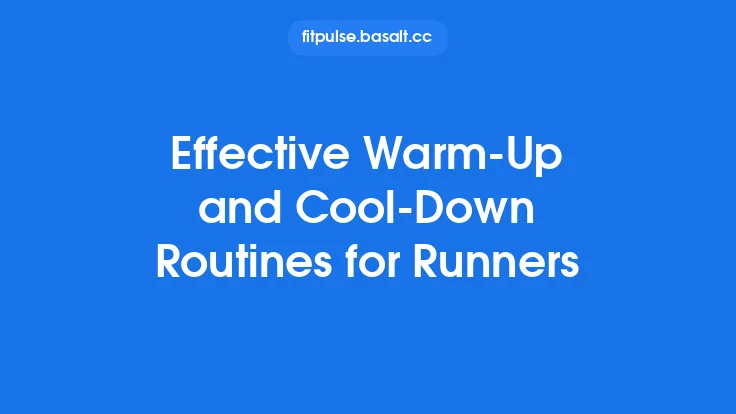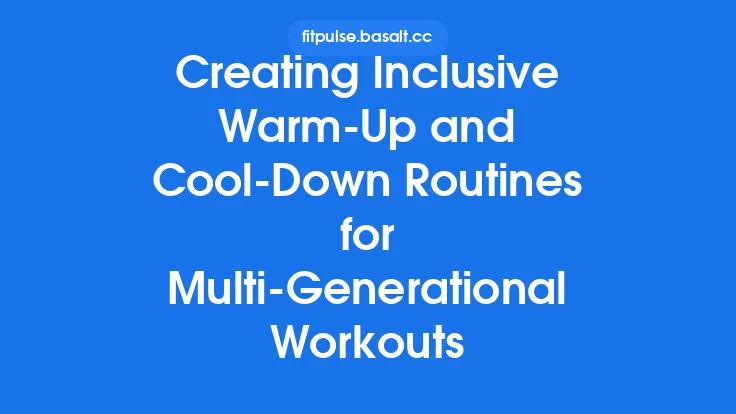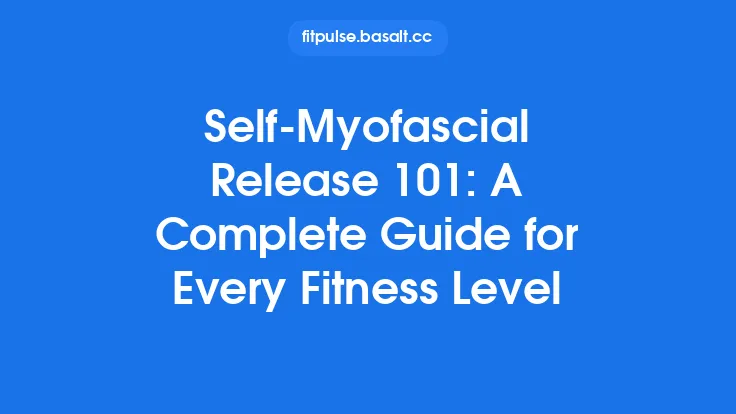Warm‑up and cool‑down periods are often treated as afterthoughts in many workout plans, yet they are critical for injury prevention, performance optimization, and long‑term recovery. Modern fitness technology now leverages artificial intelligence to generate these ancillary phases automatically, ensuring that each user—whether a sedentary beginner or an elite athlete—receives a routine that matches their current physiological state, training goals, and available equipment. This article explores the mechanics behind AI‑generated warm‑up and cool‑down sequences, the data that feed the models, how personalization is achieved across fitness levels, and practical tips for integrating these routines into everyday training.
How AI Determines the Ideal Warm‑Up
- Goal‑Based Segmentation
AI first classifies the primary objective of the upcoming session (e.g., strength, hypertrophy, endurance, mobility). Each goal has a distinct physiological demand profile, which informs the selection of activation exercises, dynamic stretches, and movement patterns.
- Dynamic Range‑of‑Motion Analysis
Using data from previous sessions—such as joint angle ranges captured by inertial measurement units (IMUs) or smartphone gyroscopes—AI estimates which joints are most constrained. The system then prioritizes mobility drills that target those deficits, ensuring a smoother transition into the main workout.
- Neuromuscular Readiness Scoring
Real‑time heart‑rate variability (HRV) and resting heart‑rate trends are fed into a readiness model. A higher HRV typically signals a well‑recovered nervous system, allowing the AI to prescribe a more vigorous activation phase. Conversely, a low HRV triggers a gentler, longer warm‑up to avoid over‑taxing the central nervous system.
- Time‑Constraint Optimization
Users often have limited windows for training. AI employs a linear programming approach to maximize the effectiveness of the warm‑up within the allotted time, balancing exercise selection, set/rep schemes, and rest intervals.
- Equipment Availability Mapping
By cross‑referencing the user’s equipment inventory (e.g., resistance bands, kettlebells, foam rollers) with the warm‑up library, the algorithm filters out incompatible movements, ensuring the routine can be executed without interruption.
Tailoring Cool‑Downs to Individual Recovery Needs
- Post‑Exercise Load Quantification
After the main session, AI calculates a cumulative load metric (e.g., volume × intensity × time). Higher load values trigger more extensive cool‑down protocols that incorporate both static stretching and low‑intensity aerobic work to facilitate lactate clearance.
- Muscle‑Specific Fatigue Detection
Wearable electromyography (EMG) patches or surface sensors can detect residual muscle activation. AI uses this data to prioritize stretching of the most fatigued muscle groups, reducing the risk of delayed‑onset muscle soreness (DOMS).
- Autonomic Recovery Monitoring
Post‑exercise HRV and skin conductance are compared against baseline values. If autonomic recovery is slower than usual, the AI extends the cool‑down duration and adds breathing or mindfulness exercises to stimulate parasympathetic activation.
- Progressive Stretching Algorithms
Rather than static, one‑size‑fits‑all stretches, AI employs a progressive overload principle for flexibility: each session’s stretch duration and intensity are incrementally adjusted based on the user’s reported range of motion improvements.
- Hydration and Nutrition Prompts
While not a physical movement, AI can embed micro‑reminders within the cool‑down flow, suggesting fluid intake or post‑workout protein timing based on the user’s dietary preferences and metabolic data.
Data Sources That Power Personalized Routines
| Data Type | Collection Method | Role in Warm‑Up / Cool‑Down Generation |
|---|---|---|
| Historical Workout Logs | App‑based session records | Determines typical load, identifies recurring weak points |
| Biomechanical Sensors (IMU, accelerometer) | Wearable bands, smartphones | Captures joint angles, movement velocity, informs mobility drills |
| Physiological Metrics (HRV, resting HR, sleep quality) | Chest strap, wrist monitor, sleep tracker | Adjusts intensity and duration based on recovery status |
| User‑Provided Preferences (time, equipment, injury history) | Onboarding questionnaire, periodic check‑ins | Filters exercise library, respects constraints |
| Environmental Context (temperature, altitude) | Device GPS, weather API | Modifies warm‑up intensity (e.g., longer warm‑up in cold climates) |
| Feedback Loop (RPE, soreness scores) | Post‑session surveys | Refines future routine recommendations through reinforcement learning |
The integration of these heterogeneous data streams enables a multi‑dimensional view of the user, allowing AI to generate warm‑up and cool‑down sequences that are both scientifically grounded and individually relevant.
Algorithmic Approaches: Rule‑Based vs. Machine‑Learning Models
- Rule‑Based Engines
- Structure: A hierarchy of IF‑THEN statements derived from exercise science literature.
- Strengths: Transparent decision pathways, easy to audit, low computational overhead.
- Limitations: Rigid; struggles to capture nuanced interactions between variables (e.g., simultaneous low HRV and high external temperature).
- Supervised Machine‑Learning Models
- Structure: Gradient‑boosted trees or neural networks trained on large datasets of user outcomes (e.g., injury incidence, performance gains).
- Strengths: Can uncover non‑linear patterns, adapt to new data without manual rule updates.
- Limitations: Requires extensive labeled data, risk of overfitting to specific demographics.
- Reinforcement Learning (RL) for Adaptive Sequencing
- Structure: An agent selects warm‑up/cool‑down actions, receives a reward based on subsequent performance metrics (e.g., reduced perceived exertion, lower post‑session soreness).
- Strengths: Continuously optimizes routine composition in real time, personalizes beyond static datasets.
- Limitations: Needs a safe exploration strategy to avoid prescribing potentially harmful sequences during learning phases.
- Hybrid Systems
Many commercial platforms combine a rule‑based backbone (ensuring safety and compliance with clinical guidelines) with a machine‑learning overlay that fine‑tunes parameters such as set counts, rest intervals, and stretch durations.
Adapting to Different Fitness Levels
| Fitness Level | Warm‑Up Characteristics | Cool‑Down Characteristics |
|---|---|---|
| Sedentary / Beginner | • Low‑intensity dynamic movements (e.g., marching in place) <br>• Emphasis on full‑body mobility <br>• Longer duration (10‑12 min) to raise core temperature gradually | • Gentle static stretches (15‑30 s) for major muscle groups <br>• Light walking or slow cycling (5 min) to aid circulation <br>• Simple breathing exercises |
| Intermediate | • Moderate‑intensity activation (e.g., banded glute bridges) <br>• Targeted joint prep based on recent training focus <br>• Balanced duration (7‑10 min) | • Combination of static and proprioceptive stretches <br>• 3‑5 min of low‑intensity cardio <br>• Optional foam‑rolling for identified tight spots |
| Advanced / Athlete | • High‑intensity dynamic drills (e.g., plyometric hops, sport‑specific movement patterns) <br>• Neuromuscular priming (e.g., rapid‑force‑development sets) <br>• Shorter, highly specific warm‑up (5‑7 min) | • Advanced mobility work (e.g., PNF stretching) <br>• Targeted myofascial release <br>• Structured autonomic recovery (e.g., HRV‑guided breathing) <br>• Longer duration if training load is exceptionally high |
AI determines the appropriate tier by evaluating the user’s training history, self‑reported competence, and physiological readiness scores. The system can also transition users between tiers automatically as performance metrics evolve.
Integrating AI‑Generated Routines with Wearable Devices
- Real‑Time Sensor Fusion
Wearables that capture heart rate, accelerometry, and skin temperature feed live data to the AI engine. If the user’s heart rate spikes prematurely during a warm‑up, the algorithm can automatically reduce intensity or extend the warm‑up phase.
- Haptic and Audio Cues
Smartwatches or earbuds can deliver timed prompts (“Begin 30‑second high‑knee march”) and vibration alerts for rest periods, ensuring the user follows the AI‑prescribed cadence without constantly checking a screen.
- Post‑Session Sync
After the cool‑down, the wearable uploads recovery metrics (HRV, post‑exercise heart rate decay) to the cloud. The AI then updates the user’s recovery profile, influencing the next session’s warm‑up length and cool‑down emphasis.
- Cross‑Platform Compatibility
Open APIs (e.g., Google Fit, Apple HealthKit) allow the AI service to pull data from multiple devices, creating a unified view of the user’s physiological state regardless of the hardware ecosystem.
Practical Implementation: From App to Gym Floor
- Step 1: Onboarding Assessment
Users complete a brief questionnaire covering fitness goals, injury history, equipment access, and typical training window. The app also requests permission to read wearable data.
- Step 2: Baseline Data Collection
Over the first week, the system records HRV, resting heart rate, and movement patterns during regular activities to establish a personalized baseline.
- Step 3: Routine Generation
When a workout is scheduled, the AI compiles a warm‑up and cool‑down plan, presenting it as a step‑by‑step video or animated guide. Each step includes visual cues, duration, and optional modifications.
- Step 4: Execution Monitoring
During the warm‑up, the wearable tracks heart rate and motion. If deviations occur (e.g., heart rate exceeds target zone), the app notifies the user and suggests adjustments.
- Step 5: Feedback Loop
After the session, the user rates perceived exertion and soreness. The AI incorporates this feedback into its reinforcement learning model, refining future recommendations.
- Step 6: Periodic Review
Every 4‑6 weeks, the app prompts a re‑assessment, allowing the AI to recalibrate fitness level classification and update the exercise library accordingly.
Common Misconceptions and Limitations
| Misconception | Reality |
|---|---|
| AI can replace a qualified trainer for warm‑up design. | AI excels at data‑driven personalization but lacks the nuanced judgment of a human coach in rare clinical scenarios (e.g., acute injury). |
| All warm‑ups generated by AI are identical for a given fitness level. | The algorithm incorporates day‑to‑day physiological variability, resulting in dynamic adjustments even within the same fitness tier. |
| Cool‑downs are optional; AI just adds them for completeness. | Research shows that structured cool‑downs improve autonomic recovery and reduce DOMS; AI‑generated cool‑downs are evidence‑based, not decorative. |
| More data always yields better routines. | Quality matters; noisy sensor data can mislead the model. Robust preprocessing and outlier detection are essential. |
| AI‑generated routines are static once created. | The system continuously learns from new data, ensuring the routine evolves with the user’s progress and changing circumstances. |
Future Directions Within Warm‑Up/Cool‑Down Personalization
- Multimodal Emotion Sensing
Incorporating facial expression analysis or voice tone detection could allow AI to gauge motivation levels, adjusting warm‑up intensity to match mental readiness.
- Adaptive Load‑Sensitive Mobility Drills
Emerging smart bands can measure tension in real time, enabling AI to prescribe resistance‑based mobility work that scales with the user’s instantaneous strength output.
- Community‑Driven Knowledge Graphs
Aggregating anonymized warm‑up and cool‑down outcomes across millions of users could feed a knowledge graph, helping the AI discover novel exercise pairings that improve recovery metrics.
- Integration with Rehabilitation Platforms
By aligning warm‑up/cool-down generation with physiotherapy protocols, AI could bridge the gap between general fitness and clinical rehab, offering seamless transitions as users move between stages of recovery.
- Explainable AI Interfaces
Future UI designs may present the rationale behind each warm‑up or cool‑down choice (e.g., “Your HRV indicates reduced parasympathetic tone; a longer breathing sequence is recommended”), fostering trust and user education.
In summary, AI‑generated warm‑up and cool‑down routines represent a convergence of exercise science, sensor technology, and intelligent algorithms. By continuously ingesting physiological data, contextual information, and user feedback, these systems deliver highly personalized preparatory and recovery phases that adapt to any fitness level. When integrated thoughtfully with wearables and presented through intuitive interfaces, AI can make the often‑overlooked edges of a workout—its beginning and its end—both safer and more effective, laying a solid foundation for sustained performance and long‑term health.





